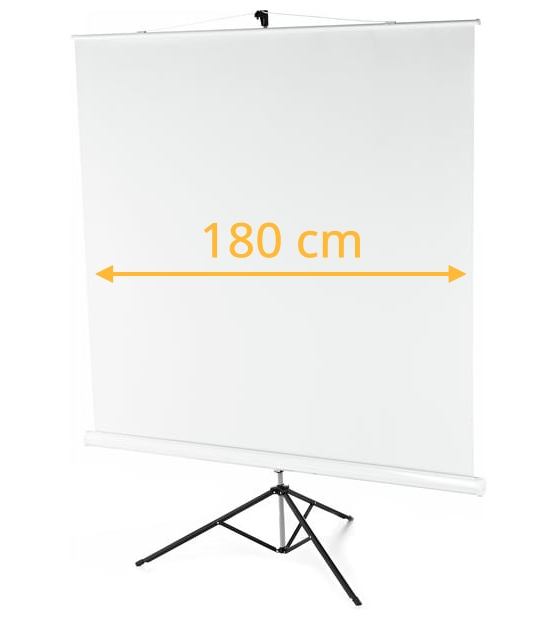
The UHD Alliance awards the «Ultra HD Premium» label for a DCI-P3 coverage of 90% or more. Most laser projectors only achieve a colour space coverage of about 80-85% of the DCI-P3 colour space. These values are good for a laser projector.

#PROJEKTOR LEINWAND TEST FULL#
709 colour space (Blu-rays, Full HD content) 100% coverage of the SDR relevant Rec.In the evening – or in a darkened living room – you don’t want a picture that’s as bright as the midday sun in the Gobi Desert south of Mongolia. Optoma has the advantage that its projector dynamically adjusts the brightness to the ambient light. It really is a balancing act between too much and too little brightness. However, it needs about 2000 ANSI lumen to make sure the picture is good enough in bright daylight. This is why most projectors don't (want to) produce more than 2000 ANSI lumens.

With too much brightness, colours will appear faded. In comparison, LG's HU85LS achieves about 2700 ANSI lumens. Good colour management thanks to HDR and HLG supportģ500 ANSI lumens – this is how much brightness Optoma’s UST projector delivers. I'm beginning to understand what Optoma means with «perfect for recreating the big-screen experience at home», even though these marketing promises still sends shivers down my spine. These slightly blurred corners were noticeable with LG's HU85LS. The top left and top right corners are often slightly blurred with UST projectors. If you’d like to know exactly how this e-Shift Technology works, check out this article (only available in German). Instead, it looks as if the Full HD image is multiplied four times and placed next to each other, resulting in a resolution four times higher than Full HD. This chip is made to vibrate so subtle and so fast that the human eye cannot perceive the vibration. To be precise, the image is created on a standard Full-HD DMD chip. Yet, they’re allowed to call themselves UHD projectors because the DLP e-Shift Technology developed by Texas Instruments creates a kind of artificial UHD. Optoma’s UHZ65UST is a UHD projector, but it doesn’t offer true UHD resolution. This saves electricity, but also reduces the image quality. LG's projector achieves the same noise level, but only in eco mode. When it’s on, the projector isn’t loud – a pleasant 26 decibels, that’s as loud as the ticking of a wristwatch. I must say, the loudspeakers that are built into the projector provide fantastic sound. Speaking of soundbars: Optoma bought its audio technology years ago by taking over the company NuForce. Okay, this interior design isn’t Stephi’s work, it’s our improvised digitec «living room.» She has a much better understanding of interior design than I do. Still, with its brass feet and fabric front, it could pass as a chic soundbar, as video producer Stephi claims. And Optoma’s UHZ65UST – I need to find a better name for this thing – doesn’t seem bulky, even though it’s almost 60 centimetres wide and 13 centimetres high. In our improvised living room in the digitec studio, the lighting conditions aren’t quite as critical. This is great in light-flooded living rooms, as a picture that’s too dark would hardly be visible.

On top of this, laser projectors are much brighter than lamp projectors. If your projector is on 8 hours a day, that’s about seven years of use. Instead, a laser – or rather several small laser diodes bundled into a beam of light – lasts for about 20,000 hours. This means, there’s no Xenon lamp that needs to be maintained and replaced after about 3,000 operating hours. Optoma's UHZ65UST also boasts laser technology. Place the projector right below the screen and nobody will block the picture when they get beer. This eliminates the logistical problems that could put you off buying a projector. To add to the magic: although the projector is so close to the canvas, it creates a large image. External playback devices sit next to the screen, as they would with a TV, and not in the middle of the living room. UST projectors can be placed almost directly underneath the canvas and project the image onto the screen from below instead of from the front. This is exactly why ultra short throw projectors (UST projectors) such as Optoma’s UHZ65UST are so popular. Setting up a projector isn’t a simple task. This is tricky, as all the logistics between projector and screen, all the playback devices that have to be connected to the projector and the heads of the people who are watching might get in the way of the light and cast shadows on the canvas. Home cinema projectors are often right in the middle of the living room and beam light and the image onto the wall or canvas at the other end of the room. Two promising technologies: «UST» and «laser» Optoma's marketing material promises «an unforgettable 4K UHD digital cinema quality image» and a device that’s «perfect for recreating the big-screen experience at home.» Sounds awesome.


 0 kommentar(er)
0 kommentar(er)
